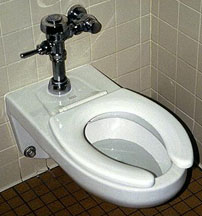
Prepared by
Diane Linder, EdD, LDN, RD

and
Melissa Brener, MS
Page 3 of 4
Most people need about 6-8 glasses
of water each day to replace daily body water losses.
|
|
Click here for the printable (Word) version of the lesson
Dehydration
Dehydration occurs when there is not enough water in your
body. Dehydration can be acute, as from illness or from
an intense exercise such as a hard workout. Dehydration can also
be chronic, resulting from your not getting over a period of
time enough water each day to replace your daily water losses.
Dehydration is defined as a 1 % to 2 % loss of body weight caused
by fluid losses. Dehydration of 2 % loss of body weight results
in impaired physiological and performance responses.
Acute dehydration can happen easily when a person is sick
(vomiting, diarrhea or fever) and losing more fluid than normal.
Young children and elderly people are especially susceptible
to dehydration. If an elderly person gets the flu, fever or diarrhea,
the amount of water in their body can decrease within days or
even hours. Elderly people have less water in their bodies
to begin with (because they have more fat and less muscle than
younger people), so they can become dehydrated quickly.
Some signs of dehydration include headache, thirst, loss of
appetite, fatigue, increased temperature, heavy breathing, faster
pulse rate, flushed skin, dry mouth and eyes, burning sensation
in the stomach, dizziness and dark urine with a strong odor.
 If you have a baby and it gets
sick with a fever, diarrhea or vomiting, check to see if he wets
his diaper. If he doesn't, he is dehydrated. A baby can become
dehydrated quickly with fever, diarrhea or vomiting. Be sure
to call the doctor's office right away when your baby gets any
of these symptoms. If you have a baby and it gets
sick with a fever, diarrhea or vomiting, check to see if he wets
his diaper. If he doesn't, he is dehydrated. A baby can become
dehydrated quickly with fever, diarrhea or vomiting. Be sure
to call the doctor's office right away when your baby gets any
of these symptoms.
Assess your own hydration status by evaluating the color of
your urine.It should be very pale yellow, pale yellow or
straw colored if you are well hydrated. If your urine
becomes dark with a strong odor, you need more water. You may
also have a medical condition with that symptom.
   [ LESSONS || SITE
MAP || LOCAL AGENTS || RESOURCES || PEOPLE ]
[ LESSONS || SITE
MAP || LOCAL AGENTS || RESOURCES || PEOPLE ]
Issued in furtherance of Cooperative Extension
work, Acts of Congress of May 8 and June 30, 1914, in cooperation with the United States
Department of Agriculture. The Louisiana Cooperative Extension Service provides equal
opportunities in programs and employment. Information and Graphics on this site are
copyright protected by LSU Agricultural Center's Louisiana Cooperative Extension Services. For more information on the EFNEP program, contact EFNEPMail@agcenter.lsu.edu.
|